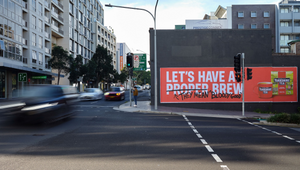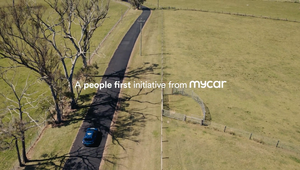
If You Have to Convince a Marketer to Buy the Idea, It’s Not Right: Katrina Alvarez-Jarratt

As creatives worry about the demise of the ‘big idea’, and marketers juggle the need to create distinctive work while battling wary boards, stretched budgets, and cautious consumers, TBWA\Sydney’s executive creative director, Katrina Alvarez-Jarratt, wants agencies to stop “convincing” clients to buy risky work.
“I don't think convincing anyone is a good strategy,” she tells LBB. “If you have to talk someone into something and put a really hard sell on it, it's probably not right.”
TBWA’s proposition is ‘disruption’, so it makes it easier to sell in disruptive ideas when clients “know what they are going to get when they come to us.” But the ECD notes disruptive ideas aren’t necessarily brave ones.
“I actually think we're using the wrong word. The word 'brave' sounds like something to a marketer that might get them fired, and no one wants to feel like that,” she tells LBB. “We should be telling clients to buy smart ideas. Not brave, smart.”
Managing clients’ risk appetite is nuanced because of the “layers that they need to sell things up into their business”. The agency’s client contact may not be risk averse, but someone far above them might be.
“I have a great deal of empathy for them. Because I've seen that change over my career, and budgets are tighter. They've got more pressure to drive growth than I think they've ever had. It makes it really hard to buy something different or try something new when you've got that pressure on you.
“But there's always a place that you can start to be disruptive. It might be in your media choices, it might be the executional style. It doesn't necessarily have to be on your really big ticket items. It doesn't have to be on your biggest bet of the year.”
She points to recent work for Modibodi and Heinz as examples of work that might seem brave, but didn’t feel brave for the client to buy.
The brief for Modibodi, a brand known for its period underwear, came via TBWA’s fashion and lifestyle agency, FABRIC. The brand platform, ‘Fear Not’, gave the agency “space to play in, because it sets up the kind of work that we're going to make for them.”
In August, the agency put Modibodi’s period swimwear to the test in ‘Shark Week’, which saw a marine biologist and free diver swimming with tiger sharks in the swimwear while menstruating.
“We'd been noodling on it,” Katrina explains. “Modibodi had a bit of an issue which was popping up on the social feed, which was every time they spoke about their swimwear products, they had people writing these comments about sharks.
“People are quite scared to use it, not because it doesn't work. It's actually the most incredibly innovative product. But people are scared to use it because they just weren't sure that it would work, and they were worried about the leakage.”
Having zeroed in on the problem, it became easy to develop ideas which responded to it. When the agency pitched in ‘Shark Week’, “there was no fear about it really, which was kind of weird given the idea. But it was more a question of how we would make it, rather than whether we were doing it or not.”
The same went for Heinz when TBWA pitched its idea for how to launch pickle-flavoured ketchup: sending a human pickle to the world’s biggest tomato festival in Spain.
“The exact same thing happened. We presented it to our clients at Heinz, again, just very smart marketers. They looked at it and went, 'Well, that's the answer.'”
The competition to find the right human pickle attracted hundreds of entries, the “costume was really beautiful, we put a lot of craft into that,” and the resulting work starring the ‘Pickle King’ felt fun and joyful.
“It's perfectly on brand for Heinz, Heinz's brand is all about irrational love. It's all about consumer centric work. So finding someone who had an obsession with pickles and then sending them into this insane tomato festival just completely made sense for the brand.”
Of the production process, Katrina notes, “we had to get permission, actually, from the mayor of Valencia to film in the festival” but when they arrived the day before, there was still one problem: they didn’t have an overhead location from which to film the crowd.
“We just got very, very lucky and had someone say, 'Hey, would you like to use my balcony?' And so we were able to get this incredible vantage point. A lot of things went right on that job. I was like, ‘The universe just wants us to make this insane thing.’”
While the Heinz and Modibodi work are very different stylistically, “the magic of both of them” is the emotion they evoke. Modibodi was “basically 'shark diving, but make it fashion'” and Heinz leaned into meme culture and a “kind of silly, internet-y” playfulness.
They were also both born from fan truths found in social media comments threads - “that’s where the nubbin of those ideas started.”
“We dug deep into those communities. Both of these campaigns kind of started in social media, right?
“Both were very much embedded in that consumer truth. ModiBodi's customers were genuinely fearful, and Heinz's were genuinely obsessed with pickles.”
Both also prioritise the “body language” of the work, Katrina says, which runs from idea through to execution. Each was designed to “look really reflective of the way that the audience wanted to experience the product, or wanted to feel.”
“So the Heinz work, it's got that lo-fi kind of vibe to it. It feels very silly. It felt really celebratory and joyful. And that's what we wanted you to feel when you tried this product.
“And then the Modibodi work, it's sophisticated, empowering, and the look and feel of that is much more cinematic and filmic.”
Both campaigns prove that when “you have a really clear problem to solve, and the work really delivers on that, then even the wildest idea doesn't feel brave, it just feels like the right answer.”
“As soon as you change the way that you're thinking about work, and you're thinking much more about 'is this the right answer for me, and is it going to do a job for me?' then it's not a risk at all. It's actually the right thing to do.”















